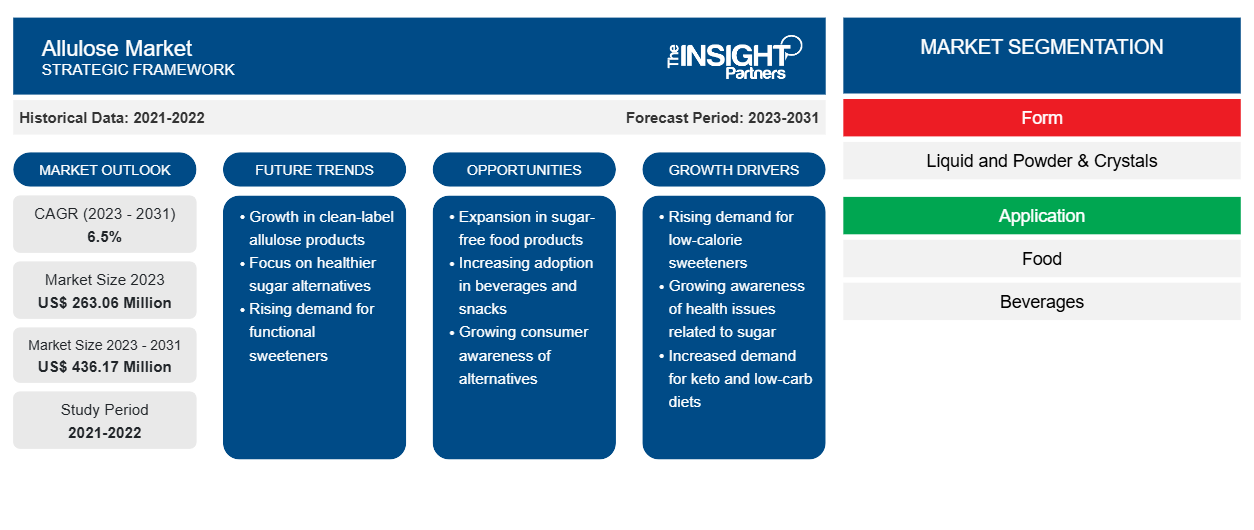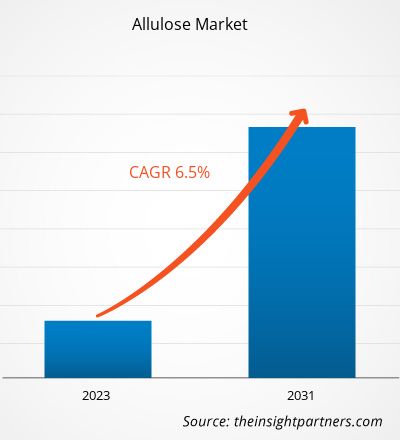The Allulose Market size is projected to reach US$ 436.17 million by 2031 from US$ 263.06 million in 2023. The market is expected to register a CAGR of 6.5% in 2023–2031. The growing popularity of the ketogenic diet among consumers across the globe is likely to remain key allulose market trends.
Allulose Market Analysis
Allulose is generally recognized as safe (GRAS) by the US Food and Drug Administration (FDA). Many food and beverage manufacturers are incorporating allulose to develop low-calorie and low-sugar products. The rising diabetic population is creating huge demand for low-sugar products. The International Federation of Diabetes has provided the diabetes statistics in its IDF Diabetes Atlas 2021 – 10th edition. According to the report, approximately 537 million people worldwide had diabetes in 2021. Among all the low-intensity sweeteners, allulose is gaining huge traction among consumers as it is 70% as sweet as sucrose and has 0.4 calories per gram, making it a perfect sugar replacement. . The rising demand for low-intensity sweeteners, owing to the rising prevalence of health issues such as diabetes and obesity, is one of the key factors driving the allulose market.
Allulose Market Overview
Allulose, often called D-allulose or D-psicose, is a rare sugar found in minuscule quantities in figs, raisins, and maple syrup. It resembles the taste and flavor of table sugar but has 10% fewer calories. The sweetness of allulose is 70% of that of table sugar. It also resembles some of table sugar’s functions, such as having a similar texture and caramelization capabilities.
Customize This Report To Suit Your Requirement
You will get customization on any report - free of charge - including parts of this report, or country-level analysis, Excel Data pack, as well as avail great offers and discounts for start-ups & universities
Allulose Market: Strategic Insights

-
Get Top Key Market Trends of this report.This FREE sample will include data analysis, ranging from market trends to estimates and forecasts.
Allulose Market Drivers and Opportunities
Favorable Government Regulations to Drive Market
The governments of various countries such as the US, India, China, and South Africa have approved the utilization of allulose in food and beverages in specified quantities. Recently, in April 2019, the Food and Drug Administration (FDA) issued draught guidance for the food and beverage manufacturers in the US with the title "The Declaration of Allulose and Calories from Allulose on Nutrition and Supplement Facts Labels." The guidance states that allulose, a low-intensity sweetener, can be removed from the total and added sugars counts on “Nutrition” and “Supplement Facts” labels when used as an ingredient in various food and beverage products.
Growing Popularity of Ketogenic Diet– An Opportunity in Allulose Market
The ketogenic diet is becoming increasingly popular as it helps in weight reduction in very less time compared to other diet plans. The ketogenic diet also helps regulate the body’s blood sugar levels and cholesterol levels, which significantly reduces the risk of type 2 diabetes and heart diseases. The rising awareness regarding health and fitness is driving the popularity of ketogenic diets among people. The ketogenic diet is also gaining popularity among sportspersons, fitness enthusiasts, and athletes. Allulose is a keto-friendly sweetener. It has only 70% sweetness of the table sugar and does not spike the blood sugar level. Food and beverages manufacturers are increasingly incorporating allulose as a sugar replacement in ketogenic diet products such as protein bars, bakery products, ice creams, and dairy products. Thus, the growing popularity of the ketogenic diet is projected to drive the allulose market over the forecast period.
Allulose Market Report Segmentation Analysis
Key segments that contributed to the derivation of the allulose market analysis are type and application.
- Based on form, the allulose market is divided into liquid and powder & crystal. Liquid segment held a larger market share in 2023.
- In terms of application, the market is bifurcated into food & beverages and others. The food & beverages segment dominated the market in 2023.
Allulose Market Share Analysis by Geography
The geographic scope of the allulose market report is mainly divided into five regions: North America, Asia Pacific, Europe, Middle East & Africa, and South America/South & Central America.
The global allulose market is significantly growing in South & Central America. In recent years, consumers in South & Central America have become more aware of the advantages of low-calorie sweeteners over artificial sweeteners. High obesity rates and decreased physical activity, owing to lifestyle changes, are increasing consumers' concerns about their health and fitness. Therefore, they are replacing table sugar with low-calorie alternatives that taste like sugar. This factor is expected to provide a strong potential for the allulose market across South & Central America.
Allulose Market Regional InsightsThe regional trends and factors influencing the Allulose Market throughout the forecast period have been thoroughly explained by the analysts at The Insight Partners. This section also discusses Allulose Market segments and geography across North America, Europe, Asia Pacific, Middle East and Africa, and South and Central America.
Allulose Market Report Scope
| Report Attribute | Details |
|---|---|
| Market size in 2023 | US$ 263.06 Million |
| Market Size by 2031 | US$ 436.17 Million |
| Global CAGR (2023 - 2031) | 6.5% |
| Historical Data | 2021-2022 |
| Forecast period | 2023-2031 |
| Segments Covered |
By Form
|
| Regions and Countries Covered |
North America
|
| Market leaders and key company profiles |
|
Allulose Market Players Density: Understanding Its Impact on Business Dynamics
The Allulose Market is growing rapidly, driven by increasing end-user demand due to factors such as evolving consumer preferences, technological advancements, and greater awareness of the product's benefits. As demand rises, businesses are expanding their offerings, innovating to meet consumer needs, and capitalizing on emerging trends, which further fuels market growth.

- Get the Allulose Market top key players overview
Allulose Market News and Recent Developments
The allulose market is evaluated by gathering qualitative and quantitative data post primary and secondary research, which includes important corporate publications, association data, and databases. The following is a list of developments in the market for innovations, business expansion and strategies:
- In March 2024, Scotty's Everyday, is excited to announce the launch of their new Allulose & Monk Fruit Zero Calorie Sugar Replacement, the sweetener blend used in their popular products. (Source: Scotty's Everyday, Press Release)
- In July 2020, Whole Earth Brands, Inc. is launching new Whole Earth Allulose Baking Blends which is plant-based, zero-calorie and sugar-free baking solutions. (Source: Whole Earth Brands, Inc, Newsletter)
Allulose Market Report Coverage and Deliverables
The “Allulose Market Size and Forecast (2021–2031)” report provides a detailed analysis of the market covering below areas:
- Market size and forecast at global, regional, and country levels for all the key market segments covered under the scope
- Market dynamics such as drivers, restraints, and key opportunities
- Key future trends
- Detailed PEST/Porter’s Five Forces and SWOT analysis
- Global and regional market analysis covering key market trends, major players, regulations, and recent market developments
- Industry landscape and competition analysis covering market concentration, heat map analysis, prominent players, and recent developments
- Detailed company profiles
- Historical Analysis (2 Years), Base Year, Forecast (7 Years) with CAGR
- PEST and SWOT Analysis
- Market Size Value / Volume - Global, Regional, Country
- Industry and Competitive Landscape
- Excel Dataset
Recent Reports
Testimonials
Reason to Buy
- Informed Decision-Making
- Understanding Market Dynamics
- Competitive Analysis
- Identifying Emerging Markets
- Customer Insights
- Market Forecasts
- Risk Mitigation
- Boosting Operational Efficiency
- Strategic Planning
- Investment Justification
- Tracking Industry Innovations
- Aligning with Regulatory Trends





















 Get Free Sample For
Get Free Sample For